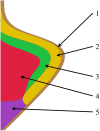Porcine vocal fold elasticity evaluation using Brillouin spectroscopy
- PMID: 37560326
- PMCID: PMC10407566
- DOI: 10.1117/1.JBO.28.8.087002
Porcine vocal fold elasticity evaluation using Brillouin spectroscopy
Abstract
Significance: The vocal folds are critically important structures within the larynx which serve the essential functions of supporting the airway, preventing aspiration, and phonation. The vocal fold mucosa has a unique multilayered architecture whose layers have discrete viscoelastic properties facilitating sound production. Perturbations in these properties lead to voice loss. Currently, vocal fold pliability is inferred clinically using laryngeal videostroboscopy and no tools are available for in vivo objective assessment.
Aim: The main objective of the present study is to evaluate viability of Brillouin microspectroscopy for differentiating vocal folds' mechanical properties against surrounding tissues.
Approach: We used Brillouin microspectroscopy as an emerging optical imaging modality capable of providing information about local viscoelastic properties of tissues in noninvasive and remote manner.
Results: Brillouin measurements of the porcine larynx vocal folds were performed. Elasticity-driven Brillouin spectral shifts were recorded and analyzed. Elastic properties, as assessed by Brillouin spectroscopy, strongly correlate with those acquired using classical elasticity measurements.
Conclusions: These results demonstrate the feasibility of Brillouin spectroscopy for vocal fold imaging. With more extensive research, this technique may provide noninvasive objective assessment of vocal fold mucosal pliability toward objective diagnoses and more targeted treatments.
Keywords: Brillouin; confocal imaging; ex vivo; larynx.
© 2023 The Authors.
Figures









References
-
- Castelijns J. A., et al. , “Imaging of the larynx,” Neuroimaging Clin. N. Am. 6, 401–415 (1996).NCNAEO - PubMed

